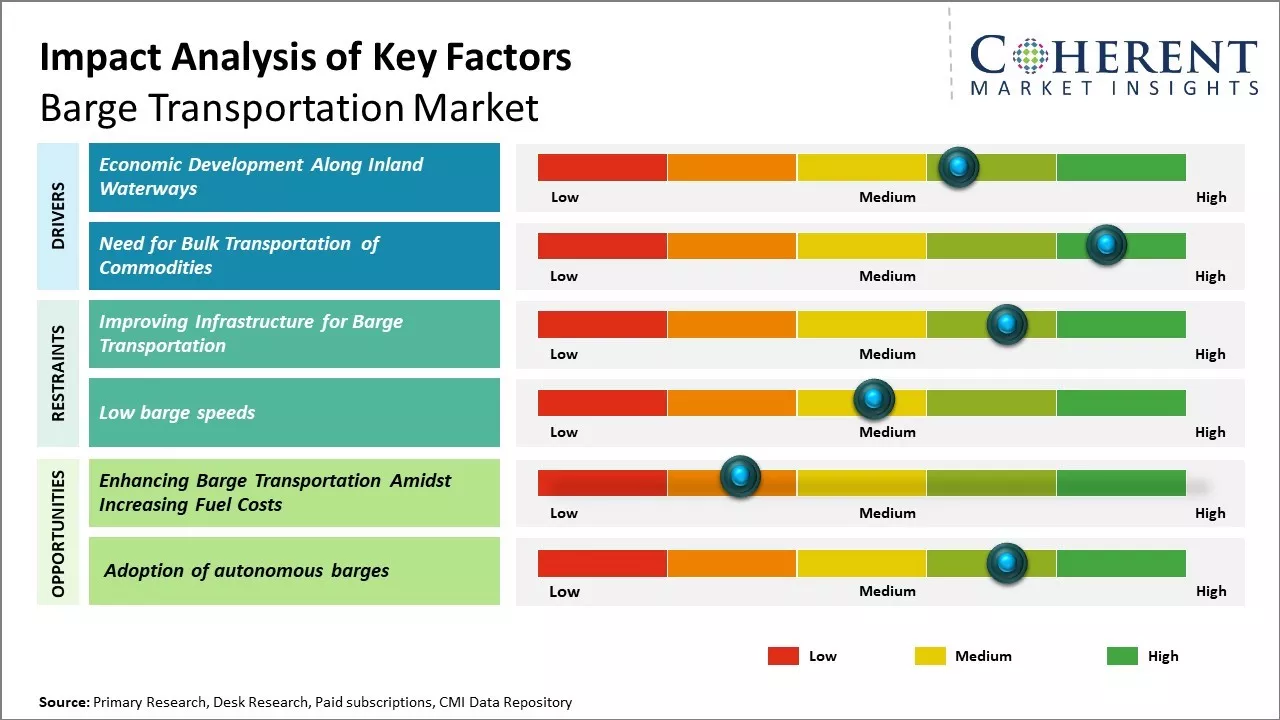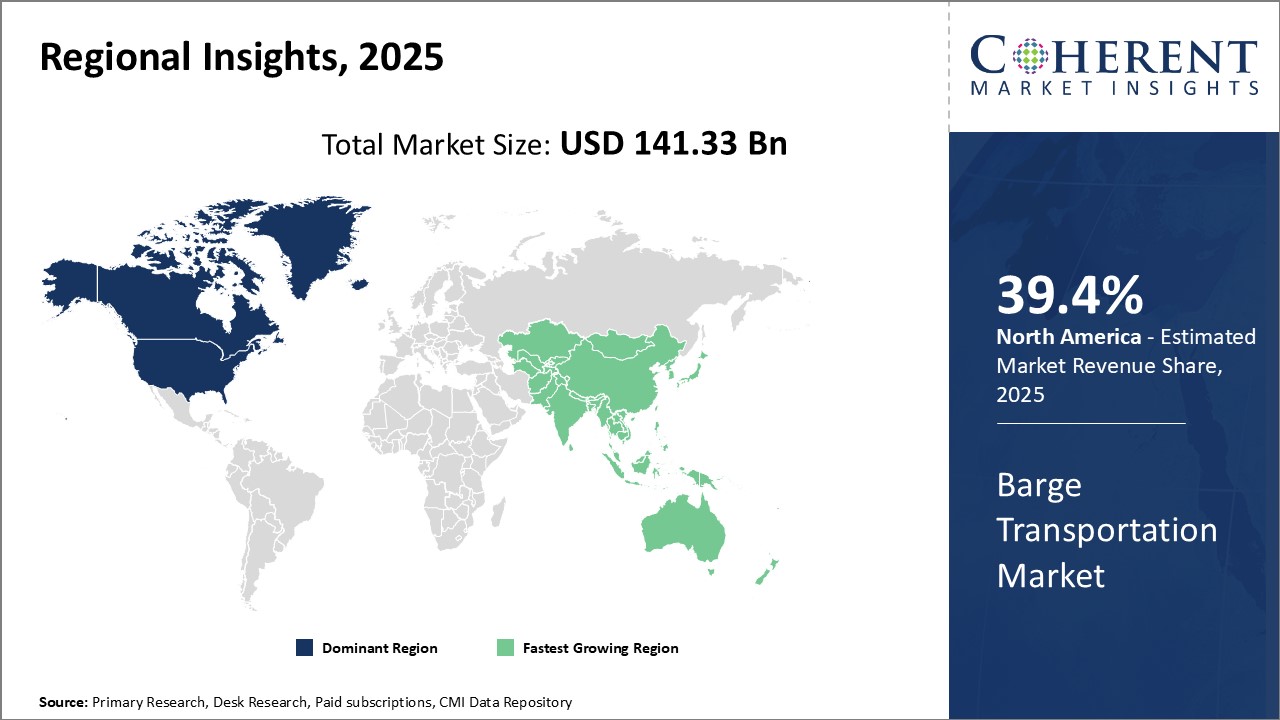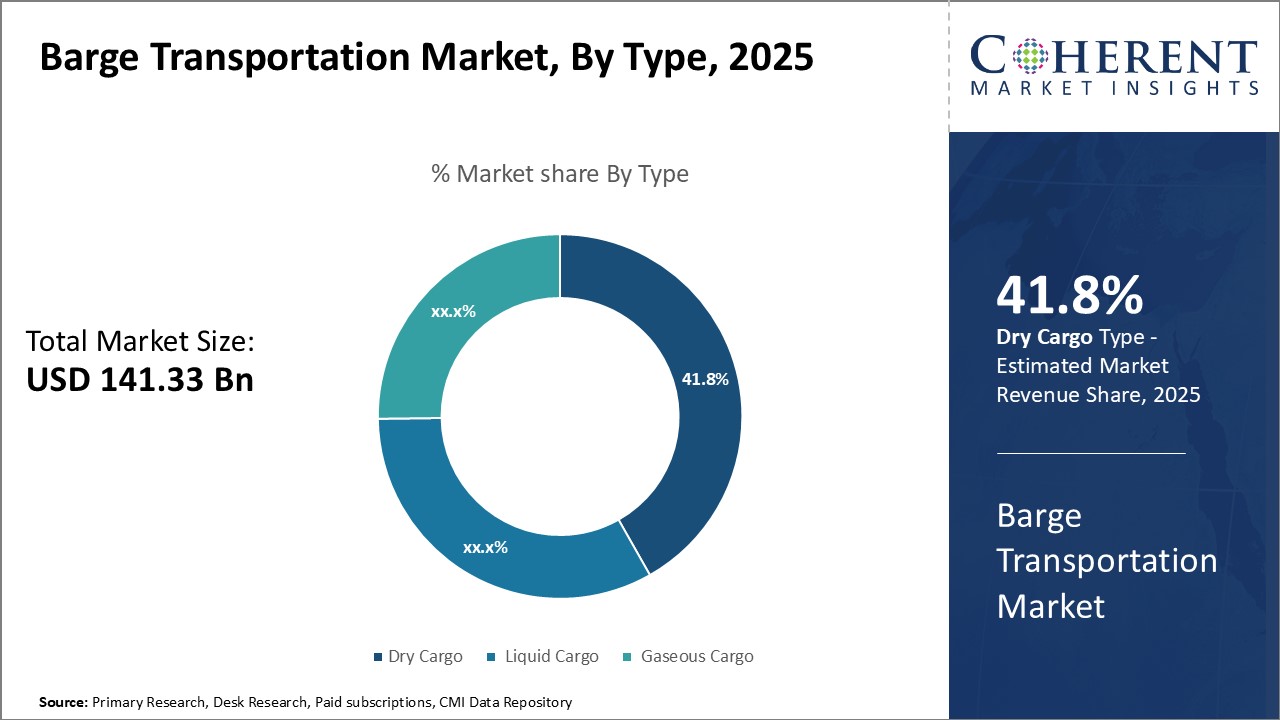Global Barge Transportation Market Size and Forecast 2025- 2032
Global barge transportation market size is estimated at USD 141.33 Bn in 2025, and is expected to reach USD 184.85 Bn by 2032, exhibiting a compound annual growth rate (CAGR) of 3.9% from 2025 to 2032.

To learn more about this report, Download Free Sample
Key Takeaways of the Global Barge Transportation Market
- Dry cargo segment is estimated to hold the largest market share, accounting for 41.8% in 2025.
- In terms of application, coke & refined petroleum products segment is estimated to contribute the highest share of 25.5% in 2025.
- North America is expected to lead the global market with 39.4% market share in 2025.
Market Overview
Global barge transportation market is expected to witness growth due to increasing demand for cost effective and fuel-efficient modes of transportation. Barges are mostly used for hauling bulk stuff like coal and grain across rivers and canals.
Increasing demand for efficient bulk transportation due to industrialization and trade, ongoing investments in inland waterway infrastructure development, and the integration of advanced digital and sustainable technologies within the sector are the main factors to fuel market growth.
Market Concentration and Competitive Landscape

To learn more about this report, Download Free Sample
Current Events and Impact
|
Current Events |
Description and its impact |
|
Geopolitical Trade Policy Shifts |
|
|
Regional Infrastructure Development |
|
Uncover macros and micros vetted on 75+ parameters: Get instant access to report
Impact of AI on Global Barge Transportation Market
The integration of Artificial Intelligence (AI) into the global barge transportation market is revolutionizing operations, enhancing safety, and boosting efficiency at every stage.
- Smart tech, or AI, is helping barges work better. Companies like Ingram Barge use this to plan trips so barges don't waste time and can dodge bad weather or traffic jams.
- SEAFAR, a Belgium-based company, integrates advanced sensors, artificial intelligence (AI), and machine learning to enable vessels to monitor waterways, autonomously regulate speed and steering to navigate safely.
Impact of U.S. Reciprocal Tariffs on the Global Barge Transportation Market
The recent escalation of reciprocal tariffs imposed by the U.S. has significantly impacted global trade. However, the shipping and logistics sector, including barge transportation, typically faces indirect impacts.
The recent 90-day tariff reprieve between the U.S. and China, initiated on May 12, 2025, has notable implications for the barge transportation sector, particularly concerning the movement of bulk commodities. For instance, Hapag-Lloyd anticipates a boost in container bookings due to the temporary tariff reduction
Consumer Behaviour Analysis in the Global Barge Transportation Market
The primary users of barge transport are companies dealing with farm goods, oil and chemicals, construction, mining, and special metal companies. Government agencies also represent a significant client segment, leveraging barge services for infrastructure projects such as waterway maintenance, flood control, and environmental restoration.
For example, companies like Cargill often use barges on the Mississippi River after harvests because it's reliable and they can move a lot of goods at once. Oil companies like ExxonMobil tend to stick with barge companies that have really good safety records for moving dangerous liquids.
Industry Trends
Shifting Cargo Landscapes and Evolving Demands
The global barge transportation market is undergoing significant changes, adapting to evolving cargo demands. This expansion is driven by growing demand for transporting diverse goods, mainly to support the e-commerce sector's need for moving containers and bulky items. For example, container barges are increasingly used to transport goods from ports to inland distribution centres, supporting faster delivery times for online retailers.
The Push for Sustainability and Technological Integration
The barge industry is facing increasing pressure to transition to more environmentally sustainable operations. Demand in electric barges is also growing. Moreover, the sector is seeing the absorption of better tracking systems and initial steps towards autonomous navigation for improved efficiency and environmental performance. For example, in March 2024, Pyxis, a Singapore-based company, introduced a solar powered electric ferry with advanced Vehicle-to-Grid technology.
Market Opportunity: Enhancing Barge Transportation Amidst Increasing Fuel Costs
Rising fuel costs make barge transportation an increasingly competitive option for heavy, bulk commodities. As road and rail congestion grows, there is growing demand for alternative transportation options with smaller carbon footprints. Investments to upgrade locks, dams, and channels could open new regions and markets for barge transportation. This would allow companies to capitalize on barge shipping's efficiency.
Barge Transportation Market Insights by Type
In terms of type, dry cargo segment is estimated to contribute the highest share of 41.8% in 2025 of the market, owing to its cost effectiveness and versatility.
Dry cargo barges are preferred for transportation of bulk commodities that does not require liquid containment or pressurized transport. The diverse range of dry bulk goods transported via barges, such as agricultural commodities, metals, and construction materials offer shippers flexibility to transport various products using the same barge type. Dry cargo barges are highly cost competitive as compared to other modes of transportation such as rail or road.
Barge Transportation Market Insights by Application
In terms of application, coke & refined petroleum products segment is estimated to contribute the highest share of 25.5% market share in 2025.
Coke remains integral to primary metal and chemical industries, sustaining barge transportation demand. With refineries, chemical plants and coke ovens concentrated along navigable waterways, barges are well positioned as a link in distribution channels for fuel and feedstock industries.
Barge Transportation Market Insights By Barge Fleet
In terms of barge fleet, tank segment is estimated to contribute the highest market share of 48.8% in 2025 owing to the specialized requirements of liquid cargo transport.
Tank barges are structured with liquid containment systems such as cargo tanks and pipelines to safely transport petroleum products and chemicals in bulk. Their design meets stringent safety regulations for pressurized transport of flammable and hazardous liquids via inland and intra-coastal waterways.
Regional Insights

To learn more about this report, Download Free Sample
North America Barge Transportation Industry Trends and Market Analysis
North America has established itself as the dominant player in the global barge transportation market. The region is expected to accounts for 39.4% of market share in 2025 owing to the significant presence of prominent barge fleet operators and cargo owners.
Barge transportation is widely used in North America for bulk cargo transportation along inland waterways, in both domestic and import-export operations. Major river systems such as Mississippi, Ohio, and Missouri play a critical role in enabling the lucrative barge trade within the region and with other parts of the world.
Market Research on Asia Pacific Barge Transportation: Key Trends and Regional Insights
Asia Pacific is emerging as the fastest growing regional market. Rapid industrialization and infrastructure development have significantly contributed to the growth of project and bulk cargo volumes transported via barges within the region.
Countries like China, India, and emerging ASEAN nations such as Vietnam are driving this growth trend with increased domestic production and exports. Infrastructure developments like China's One Belt One Road initiative and the expansion of inland waterways along rivers such as the Yangtze have enhanced both bilateral and transit barge trades. Countries in Southeast Asia have also upgraded various inland ports and waterways to handle increased capacities. This has made Asia Pacific an attractive market for barge operators seeking new opportunities.
U.S. Barge Transportation Industry Report
Growing demand for cost-effective bulk cargo transport, adoption of technology for improved navigation and fleet management, and expansion of domestic energy production drive the U.S. barge transportation market.
The U.S. operates around 30,000 barges on 12,000 miles of commercially navigable channels. The U.S. companies such as American Commercial Barge Line, Ingram Barge Company, and others maintain large fleets and serve both domestic and international markets, leveraging the country’s extensive inland waterway system.
India Barge Transportation Market Trends and Analysis
India barge transport sector is growing rapidly. This is because it's a cost-effective and fuel-efficient way to move big loads, especially with crowded roads and railways. Recent government initiative such as Cargo Promotion Scheme, launched in 2024, offers 35% incentive to promote the utilization of inland waterways for cargo movement, particularly on National Waterways 1, 2, and 16.
Market Report Scope
Barge Transportation Market Report Coverage
| Report Coverage | Details | ||
|---|---|---|---|
| Base Year: | 2024 | Market Size in 2025: | USD 141.33 Bn |
| Historical Data for: | 2020 To 2024 | Forecast Period: | 2025 To 2032 |
| Forecast Period 2025 to 2032 CAGR: | 3.9% | 2032 Value Projection: | USD 184.85 Bn |
| Geographies covered: |
|
||
| Segments covered: |
|
||
| Companies covered: |
ABC India Ltd., Alter Logistics, American Commercial Barge Line (ACBL), Anderson Trucking Service Inc., Bouchard Transportation Co. Inc., Blessey Marine, Canal Barge Company, Campbell Transportation Company Inc., Crowley Maritime Corporation, Heartland Barge Management LLC, Ingram Marine Group, Kirby Corporation, McAllister Towing and Transportation Co. Inc., Marquette Transportation Company LLC, Neska Container Line B.V., PACC Offshore Services Holdings Ltd., Poh Tiong Choon Logistics Ltd., SEACOR Marine Holdings Inc., Summit Eleven Inc. |
||
| Growth Drivers: |
|
||
| Restraints & Challenges: |
|
||
Uncover macros and micros vetted on 75+ parameters: Get instant access to report
Global Barge Transportation Market Industry News
- In 2023, Navalt, an India-based shipbuilding company, launched Barracuda, a solar-electric workboat. This is India’s fastest solar-electric boat.
- In June 2023, Cargill launched the world’s first zero-emission E-Pusher and E-Barges in partnership with Kotug International.
- In October 2022, Maritime Partners, a U.S.-based maritime assets and vessel leasing solutions provider, acquired M/G Transport Services. Through this acquisition, Maritime Partners aims to enhance its operational capabilities and diversify its fleet.
Analyst View
- There is the rapid growth in the global barge transportation market. This expansion is reinforced by the intrinsic cost-effectiveness and environmental advantages of barge transport for bulk commodities.
- Detailed analysis reveals that the market is gradually evolving from traditional operations toward data-driven logistics and real-time fleet tracking
- Success in the global barge transportation market necessitates a refined understanding of regional market dynamics and a proactive approach towards technological advancements and sustainable operational practices to ensure long-term competitiveness.
- Long-term business growth depends on infrastructure modernization, regulatory alignment, and enhanced integration with other transport modes.
Market Segmentation
- Type Insights (Revenue, US$ BN, 2020 - 2032)
- Dry Cargo
- Liquid Cargo
- Gaseous Cargo
- Barge Fleet Insights (Revenue, US$ BN, 2020 - 2032)
- Covered
- Open
- Tank
- Application Insights (Revenue, US$ BN, 2020 - 2032)
- Agricultural Products
- Coal & Crude Petroleum
- Metal Ores
- Coke & Refined Petroleum Products
- Food Products
- Secondary Raw Materials & Wastes
- Beverages & Tobacco
- Rubber & Plastic
- Chemicals
- Nuclear Fuel
- Regional Insights (Revenue, US$ BN, 2020 - 2032)
- North America
- U.S.
- Canada
- Latin America
- Brazil
- Argentina
- Mexico
- Rest of Latin America
- Europe
- Germany
- U.K.
- France
- Italy
- Russia
- Rest of Europe
- Asia Pacific
- China
- India
- Japan
- Australia
- South Korea
- ASEAN
- Rest of Asia Pacific
- Middle East & Africa
- GCC Countries
- South Africa
- Rest of Middle East & Africa
- North America
- Key Players Insights
- ABC India Ltd.
- Alter Logistics
- American Commercial Barge Line (ACBL)
- Anderson Trucking Service Inc.
- Bouchard Transportation Co. Inc.
- Blessey Marine
- Canal Barge Company
- Campbell Transportation Company Inc.
- Crowley Maritime Corporation
- Heartland Barge Management LLC
- Ingram Marine Group
- Kirby Corporation
- McAllister Towing and Transportation Co. Inc.
- Marquette Transportation Company LLC
- Neska Container Line B.V.
- PACC Offshore Services Holdings Ltd.
- Poh Tiong Choon Logistics Ltd.
- SEACOR Marine Holdings Inc.
- Summit Eleven Inc.
Sources
Stakeholders:
- Senior Executives from Barge Operators
- Supply Chain and Logistics Managers
- Maritime Regulatory Authorities
- Port and Harbor Authorities
- Others
Databases:
- UNCTADstat
- OECD Maritime Transport Database
- IMF Database
- Others
Magazines:
- Marine Log Magazine
- Maritime Reporter and Engineering News
- International Transport Journal
- Others
Journals:
- Journal of Maritime Logistics and Economics
- Maritime Policy & Management
- International Journal of Shipping and Transport Logistics
- Others
Newspapers:
- Lloyd's List
- The Maritime Executive
- American Shipper
- Financial Times
- Others
Associations:
- American Waterways Operators (AWO)
- European Barge Union (EBU)
- World Shipping Council (WSC)
- Inland Rivers, Ports, and Terminals Association (IRPT)
- Others
Public Domain sources:
- The World Bank
- U.S. Department of Transportation-Maritime Administration
- U.S. Army Corps of Engineers Navigation Data Center
- Others
Proprietary Elements:
- CMI Data Analytics Tool, Proprietary CMI Existing Repository of information for last 8 years
*Definition: Barge transportation market involves the transport of cargo such as commodities, goods, and raw materials via barge shipments on inland waterways like rivers, lakes, and canals. Barges offer a cost-effective mode of transportation for bulk shipments of items such as grains, coal, petroleum, steel, and gravel over long distances along water routes. Companies in this market operate tugboats that pull loaded barges between ports and facilitate the transfer of goods from barges to ports via cranes and other
Share
Share
About Author
Ameya Thakkar is a seasoned management consultant with 9+ years of experience optimizing operations and driving growth for companies in the automotive and transportation sector. As a senior consultant at CMI, Ameya has led strategic initiatives that have delivered over $50M in cost savings and revenue gains for clients. Ameya specializes in supply chain optimization, process re-engineering, and identification of deep revenue pockets. He has deep expertise in the automotive industry, having worked with major OEMs and suppliers on complex challenges such as supplier analysis, demand analysis, competitive analysis, and Industry 4.0 implementation.
Missing comfort of reading report in your local language? Find your preferred language :
Transform your Strategy with Exclusive Trending Reports :
Frequently Asked Questions
EXISTING CLIENTELE
Joining thousands of companies around the world committed to making the Excellent Business Solutions.
View All Our Clients

